New South Wales (NSW) is Australia's first and most populous state. Its capital, Sydney is the country's oldest, largest and most cosmopolitan city, centred on its spectacular harbour. The state's coastal areas offer endless sandy beaches next to sleepy coastal communities. The Great Dividing Range stretches the length of the state from north to south, including the world heritage listed Blue Mountains, much of its World Heritage listed Gondwana Rainforests, and the Southern Hemisphere's largest ski resorts in the Snowy Mountains. West of the range are the plains and the outback, gold mining, history and rural communities all the way to the red dust. Along the way you'll find Australia's premier wine regions of Mudgee and the Hunter Valley, the rainforests of the North Coast and New England, and hidden natural wonders to discover.
Regions
[edit]New South Wales is a diverse state with many different types of climate, scenery and communities. The first list of regions are all within three hours' drive or train trip from Sydney; the rest will take more time or planning.
Sydney and surrounds
[edit]
| Sydney The capital of the state and largest city in Australia, and its suburban surroundings, forms its own vibrant region |
| Blue Mountains Immediately to the west of Sydney, a region of unique scenery and wilderness |
| Central Coast Immediately north of Sydney, a region of bush, waterways and beaches. |
| Hunter Home to NSW's second city of Newcastle and some of the best vineyards in Australia |
| Illawarra Just south of Sydney: beaches, bushwalking, and the coastal cities of Wollongong and Shellharbour |
| Shoalhaven Beautiful coastal area, home to the cities of Nowra and Bomaderry, with sandy beaches, small communities, and rolling green meadows |
| Southern Highlands A day trip or a weekend away from Sydney. Bushwalking, forests, country pubs and cafes, antiques, crafts and country communities. |
Further afield
[edit]| Central West The rolling flat plains to the west of the Great Dividing Range. Home to the towns of Bathurst and Dubbo and the wine region of Mudgee |
| Outback NSW Outback New South Wales, including the city of Broken Hill and the opal mining town of Lightning Ridge along with nothing in sight for kilometres. |
| Mid-North Coast Publicised as the "holiday coast"; includes Port Macquarie and the popular tourist city of Coffs Harbour. Has popular beachside and camping spots, and gets particularly utilised during the holiday seasons. |
| New England Home to numerous Gondwana Rainforest World Heritage-listed parks, the country music capital of Tamworth, and the pretty seasonal city of Armidale |
| Northern Rivers Home to numerous World Heritage Listed National Parks, as well as the celebrity-town of Byron Bay and the towns of Lismore and Grafton |
| Riverina The state's "food bowl" with small friendly communities, great food and wine, and unique scenery. Home to the cities of Wagga Wagga, Griffith and Albury. |
| Southeastern New South Wales (Sapphire Coast, Snowy Mountains and Eurobodalla) Contains some of the state's finest, unspoiled beaches as well as snow-capped mountains with elevations of over 2000 metres, including mainland Australia's highest. |
Cities
[edit]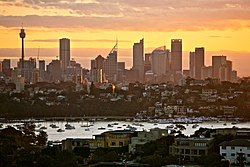
- 1 Sydney - the state capital and the largest city in Australia
- 2 Armidale - centre of the Northern Tablelands region, a city with easy road access to several World Heritage-listed national parks.
- 3 Broken Hill - a poetically named 'Wild West' mining town, right in the Outback, with a small thriving arts scene
- 4 Coffs Harbour - a popular beachfront city for visitors and seachangers, with many accommodation options from the budget to resort.
- 5 Dubbo - located in the centre of the state, it's Australia's wildlife and animal capital
- 6 Newcastle - the second largest city in NSW is a coastal city and industrial capital of the Hunter Valley region, around 150km north of Sydney.
- 7 Tamworth - Australia's home of country music.
- 8 Wagga Wagga - the largest inland city in New South Wales, on the banks of the Murrumbidgee River.
- 9 Wollongong - around 100km south of Sydney between the escarpment and the coast, natural beauty and heavy industry sit adjacent in the Illawarra region.
Other destinations
[edit]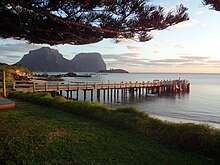
- 1 Blue Mountains National Park – world heritage listed national park, and significant mountain to indigenous Australians
- 2 Dorrigo National Park – one of the largest Gondwana rainforests left standing today
- 3 Jenolan Caves – some of the world's most finest karst landscapes and the oldest known caves on Earth
- 4 Jervis Bay – home to some of the world's whitest beaches
- 5 Kosciuszko National Park – the tallest mountain on the Australian mainland
- 6 Lord Howe Island – a world heritage-listed island some 550 km from the mainland and a popular getaway destination
- 7 Mungo National Park – home to the oldest modern human bodies outside Africa which belong to the world's oldest living civilization
- 8 Sydney Harbour National Park – a harbourside national park, home to a lot of WWII era military fortifications, beside one of the icons of Australia
- 9 Wollumbin National Park – the world's largest extinct volcano
Understand
[edit]History
[edit]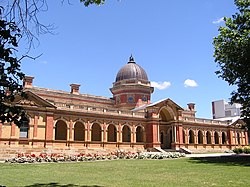
The home of a large number of Aboriginal tribes for thousands of years, New South Wales was only settled by Europeans in 1788 - spreading outwards from Sydney. The name was given by Captain Cook 18 years earlier during his first voyage of discovery, after the country of Wales. It is unknown whether he intended to name it after South Wales, or whether this new land was the Wales of the South, but the cliffs he was passing to the south of Sydney bear a striking resemblance to the cliffs along the Welsh Cambrian Coast.
When the Colony of New South Wales was established, it practically included the eastern two-thirds of mainland Australia, Van Diemen's Land (now Tasmania), New Zealand, and a few Subantarctic islands. Later the colonies of Van Diemen's Land and New Zealand were separated, and in the mid-1800s, the free-settler province (known at the time) of South Australia was established. Not long after, Queensland and Victoria were established, with what is now the Northern Territory divided between South Australia and Queensland. While there have been two more territories established (the ACT and JBT), the state has largely stayed intact since the 1860s.
The first settlers were dependent of farming and fresh water, and the major settlements grew around Parramatta and Windsor, at the limit of navigation of the Parramatta and Hawkesbury Rivers, inland from Sydney. Inland settlement was at first impeded by the rugged Blue Mountains and the Great Dividing Range as a whole for a time and settlers did not cross the mountains until 1813. However, once crossed settlement spread west rapidly, with the first road across the mountains finished in 1815, leading to the first inland towns of Goulburn and Bathurst. Further regional and rural expansion occurred in the late 19th century as a result of the Gold Rush, although it did not have as much of an impact as in neighbouring Victoria.
From its inception until the time of federation in 1901, New South Wales was dependent largely on its agricultural resources; however, over the early 20th century this largely changed to a point where New South Wales led Australia in heavy industry. This was, and continues to be dominated by industries such as coal mining in the Hunter and Illawarra regions.
From the 1970s, industries such as steel and shipbuilding began to diminish, and although agriculture remains important its share of the state's income is smaller than at any other time in the state's history. NSW, and in particular Sydney, have developed significant service industries in finance, information technology and tourism.
Geography
[edit]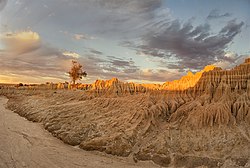
New South Wales is the most populous state in Australia. Most of that population is concentrated in Sydney, which has 5.2 million of the state's 8.2 million inhabitants. The next largest cities are (in order) Newcastle (≈600k), the Central Coast (≈400k), and Wollongong (≈300k). After that the larger cities and towns in the state are merely moderately-sized regional centres of 40,000–80,000 people. Many of the cultural sights are concentrated in Sydney and nearby.
Though Australia is characterised to have nearly every single type of landscape possible, the state of NSW would pretty much fulfill that criteria in nearly every aspect, owing to the state's large area – so large, that's it's larger than every single US state but Alaska, all Canadian provinces but Ontario and Quebec, and all European countries except Russia and the Kingdom of Denmark (which includes the Faroes and Greenland).
Though New South Wales has the smallest coastline of any state, pristine beaches near idyllic towns mostly characterise the 2,000-kilometre (1,200 mi) coastline, deserts characterise the west and northwest, mountains characterise most of the central eastern areas, while lush green rainforests and bushland flourish the far eastern near-coastal regions. Even the mountainous regions alone are diverse – the Snowy Mountains in the southeast are covered in snow and are sometimes rather treeless, while trees, valleys, and impressive canyons and gorges fill the Blue Mountains, while rainforests dating from the times of Gondwana are scattered throughout the North Coast and New England regions.
Though many of NSW's cultural sights are in Sydney or its surrounds, this isn't true of historical or natural sights. Many of the state's most beautiful natural sights, obviously enough, lie well outside the Sydney metropolitan area. Australian history and identity is to some extent tied up with rural settlement and lifestyle, and thus you will find many of the outlying regions of New South Wales base their tourism industry around pioneer and rural history.
Climate
[edit]New South Wales' climate varies considerably depending on the area in the state.
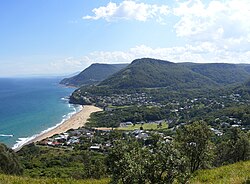
In winter the Snowy Mountains can receive significant snowfalls, with an extensive ski fields operating between July and September. During cold snaps in mid-winter snow can fall down to 800 metres in inland New South Wales, giving a light snow cover to large areas of the state. The desert areas of inland New South Wales struggle to reach 15°C, and southern coastal areas including Sydney range between 9-17°C in July, the coldest month. However the north coast of New South Wales, towards Tweed Heads and Byron Bay, averages above 20°C even during mid-winter with decently warm waters. Winter generally isn't the time for beach swimming in most New South Wales, with the season generally being between October and March – maybe a little earlier up north, and maybe a little later down south.
In summer most head for coastal regions, with New South Wales having literally hundreds of clean patrolled beaches and coastal towns. The inland towns can be hot, with many averaging over 30°C in summer, often peaking above 40°C. After Christmas until the end of January it can be difficult to find any available accommodation near the coast at short notice.
The best time to visit New South Wales depends on your interest. Most activities, transport, restaurants and other facilities operate year-round. For the beach holiday summer December to February is perfect. It can be hot, but if you are the beach, that is the way you want it. The best months for reliable snowfalls are August to September, although you are always at the whim of Mother Nature on the ski fields. Spring and Autumn are good for walking, and for country driving holiday.
If you are exploring Sydney and the cities, avoiding the summer period will reduce the crowds and peak accommodation costs. If you are used to the dry heat, then heading inland in the summer period is also an off-peak experience, with few crowds and accommodation hassles.
The Bureau of Meteorology provides weather forecasts across the state.
People
[edit]
Sydney, in particular, is ethnically diverse with many different cultural influences and language groups.
While most New South Welsh people don't use as much slang as many other states (notably Queensland), New South Welsh people use some particular regional words which are not used in other states. The word cossie or swimmers (short for swimming costume) refer to a bathing suit – don't call them "togs" as used in Queensland or "bathers" as used in Victoria. Swimsuit for women or Speedos for men are universally understood.
In common with most Australians, the people of New South Wales have a tradition of great sporting rivalry with neighbouring states. This is expressed each year, for example, in the State of Origin Series of Rugby League matches between NSW and Queensland.
Rugby League is the winter ball sport of choice in NSW and Queensland, as opposed to the rest of Australia which follows Australian Rules football. The word "football" or "footy" usually refers to Rugby League and not to soccer or Australian Rules Football. As you get down to the southern New South Wales border town of Albury, the Victorian Aussie Rules influence becomes stronger. If you go to see the Albury Football club play, they will be scoring goals and behinds rather than tries and conversions. Rugby Union is also followed by some. A-League Soccer is aligned with the northern hemisphere competitions, in the Australian summer.
Time zone
[edit]New South Wales is 10 hours ahead of Coordinated Universal Time (UTC±0). Daylight savings is observed from the first Sunday of October to the first Sunday of April the following year.
- AEST - Australian Eastern Standard Time UTC+10
- AEDT - Australian Eastern Daylight Saving Time UTC+11
- ACST - Australian Central Standard Time UTC+9.5 (Used in Broken Hill and Silverton)
- ACDT - Australian Central Daylight Time UTC+10.5 (Used in Broken Hill and Silverton)
- LHST - Lord Howe Island Standard Time UTC+10.5
- LHDT - Lord Howe Island Daylight Saving Time UTC+11
The area around the city of Broken Hill and Silverton in the far west of New South Wales is on Australian Central Standard Time (the same as South Australia), UTC+9.5 or UTC+10.5 during daylight savings time.
Norfolk Island also has its own time zone different from the rest of the state. Unlike the rest of the state, Norfolk Island does not observe daylight saving time.
Lord Howe Island also has its own time zone different from the rest of the state. However, Lord Howe Island is the only place in the world to observe daylight savings by only half and hour, instead of one hour.
Tourist information
[edit]The state tourism organization Visit New South Wales [www.visitnsw.com] operates many regional information centres. There are Accredited Visitor Information Centres located all over NSW, easily recognisable by their blue and yellow signs. Sydney has its own tourism region [www.sydney.com] and maintains several information centres, the most central being the Customs House Sydney Visitor Information Centre, at 31 Alfred Street.
- Visit NSW website
Get in
[edit]Quarantine
[edit]As with travel in other parts of Australia, travelling distances with fruit, vegetables and plant material from fruit and vegetable plants is not allowed. Its always a good idea to consume any fresh fruit or vegetables in the area in which you buy it. You'll be subject to an on-the-spot fine of around $200, or could even be prosecuted if you're found to been acting wilfully in taking fresh fruit and vegetables into protected areas such as the Riverina, the north coast, and even to the outback areas of Broken Hill and Hay. A tougher restriction zone, the Greater Sunraysia Pest Free Area applies to some areas around the Victorian border near Mildura.
You'll see signs and bins for disposal along the roads heading towards protected areas and at airports. So don't stock up bananas up in Coffs Harbour if you are heading down to Narrandera. Griffith and Wagga Wagga. You'll risk widespread damage to crops from fruit-fly and other pests, and you could well be fined.
For more information on domestic quarantine, see the government website.
Buying fruits and vegetables in the areas immediately surrounding Sydney and bringing them into Sydney is fine, so feel free to stop and some of the farm gates in the Blue Mountains, and along the Hawkesbury without concern.
By plane
[edit]Most air travellers to New South Wales arrive at Sydney Airport, near the Sydney central business district, which is Australia's largest airport.
Seven other airports in New South Wales have interstate flights:
- Flights from Brisbane, the Gold Coast, Melbourne, Canberra and Norfolk Island operate to Newcastle Airport.
- Flights from Melbourne and Canberra operate to Albury Airport.
- Flights from Melbourne and Brisbane operate to Coffs Harbour Airport.
- Flights from Melbourne operate to Ballina Byron Airport.
- Flights from Brisbane operate to Port Macquarie Airport
- Flights from Brisbane operate to Tamworth Airport
- Flights from Adelaide operate to Broken Hill Airport.
Note that flights from some of these destinations do not operate every day.
International and domestic visitors to the Northern Rivers including Byron Bay should consider the Gold Coast Airport, which is only minutes from the New South Wales northern border, and has many domestic and some international flights. Similarly, interstate travellers visiting the southeast of New South Wales may choose to fly through Canberra Airport, to access the Snowy Mountains, Eurobodalla, Sapphire Coast or eastern Riverina areas.
By road
[edit]
Travellers arriving overland will usually pass through the (near) border towns of Broken Hill from South Australia, Albury-Wodonga or Eden from Victoria and Tweed Heads from Queensland. New South Wales is linked by sealed highways to the three surrounding states. The main routes used by motorists into New South Wales are as follows:
- From Queensland:
- via the M1 Pacific Motorway, entering at Tweed Heads/Coolangatta, at the south end of the Gold Coast
- via the A15 New England Highway, entering at Wallangarra/Jennings, approximately 250 km southwest of Brisbane
- via the A39 Newell Highway, entering at Goondiwindi.
- From South Australia:
- via the A32 Barrier Highway, entering at Cockburn, approximately 50km west of Broken Hill
- From Victoria:
- via the M31 Hume Freeway, entering at Albury
- via the A1 Princes Highway, entering about 50 km south of Eden.
- via the A20 Sturt Highway (often used by motorists coming directly from Adelaide), entering just north of Mildura.
- From the Australian Capital Territory:
- via the M23 Federal Highway, the main way to enter from Canberra
- via the A25 Barton Highway, the northwesterly alternative
- via the A23 Monaro Highway, the highway to the Snowy Mountains
By rail
[edit]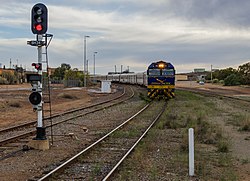
Sydney is one of the major hubs of rail services in Australia, and trains run from every mainland state capital city in Australia directly to Sydney. The interstate rail providers are as follows:
- NSW TrainLink Regional, run by the New South Wales Government, runs several interstate services. Trains run twice daily from Melbourne, two or three times daily from Canberra and once a day from Brisbane. These trains are much slower than flying, and slower than a coach, but are a relaxed way to see the Australian countryside.
- Journey Beyond run interstate services which are more of a tourist train than a passenger service, but still provide a chance to see the spectacular countryside. The world-famous Indian Pacific connects Perth with Sydney via Adelaide. Passengers from Darwin and Alice Springs can change services from The Ghan in Adelaide.
NSW TrainLink Regional trains stop at intermediate stations on their way to and from Sydney, where it may be possible to change to bus services if you are not travelling direct to Sydney, and its pricing is generally competitive with plane or bus travel. Journey Beyond costs more than flying in business class and does not stop permit passengers to begin or end their journeys at intermediate stations other than Adelaide, meaning that it should only be considered for the experience rather than as a practical means of transport.
By sea
[edit]- Sydney Harbour is one of the major stops for cruise ships during the summer season. Vessels from all around the world including Holland America Line, Princess Cruises and Royal Caribbean all offer cruises to New South Wales. descend on Sydney every year and dock at various ports within Sydney, including the International Passenger Terminal.
- Newcastle Harbour also receives some cruise ships, mainly from P&O Cruises to the Pacific.
- If you wish to sail your own boat, for detailed information about sailing into NSW coastal ports contact the New South Wales Maritime Authority. Ports with customs officers are also available at Eden on the Sapphire Coast and Yamba on the Northern Rivers.
Get around
[edit]60% of the state's population lives in Greater Sydney and much of the intercity transport infrastructure is dedicated to taking travellers to and from Sydney, and to a lesser extent, Newcastle.
Transport connections between other New South Wales towns are often much less convenient. There is usually a reasonably direct road route between any two New South Wales towns, but public transport links are likely to be abysmal or non-existent, unless the two towns are on the same route to Sydney. As in the rest of Australia, there is very much a culture of making your own way by car.
It is common for travellers to make their way up or down the coast from Sydney by bus. Buses traverse these coastal routes several times a day, and it is quite possible to stop off at a few of the coastal towns of your choosing.
Expect public transport within cities or towns to be basic or non-existent outside Sydney. Much of the public transport there is largely designed for school children. There are some exceptions. The northeast corner of New South Wales including Tweed Heads and Kingscliff is reasonably well serviced by an extension of the Gold Coast transport network. Newcastle has a decent bus, light rail and ferry network, while Wollongong and the Blue Mountains have passable bus and train networks. In other New South Wales cities expect taxis, and an irregular bus services at best.
Travellers who wish to tour the regions of NSW have little option other than to travel by car or take a tour when travelling beyond the main transport routes in and out of Sydney.
Road signage and visitor radio
[edit]There is standardised road signage for tourist attractions in NSW, that is a white text on a brown sign. All attractions signposted this way within the road reservation have to be approved have to meet a minimum standard of facilities for visitors, including tourist drives. Similarly tourist information centres signposted within the road reservation must be official centres. They are indicated by the italic i on a blue background, in contrast to shops, etc, that display the sign in their window.
Visitor radio is available in many towns as you drive through. There will be a signpost with the frequency near the entry to the town. If the radio is signposted in the road reservation it is an approved service, and must carry at least 50% of content unpaid, so there must be some information between the advertisements.
Information bays are often just outside of towns, where you can pull over and see the attractions of a region or a town before entering.
By plane
[edit]Most New South Wales cities are within a day's drive of each other, there are a number of airlines that connect cities in the state:
- Qantas has flights between Sydney and many cities and towns throughout the regions;
- Regional Express has flights between Sydney and cities in the North Coast, New England, Riverina, Central West, Far West and South Coast regions;
- Virgin Australia
- Airlink flies between Sydney, Bathurst and Dubbo, and has charter services available to a number of towns in the Central West and Far West of the state;
- Flight Dynamics flies between Sydney, Bathurst, Dubbo, Brisbane and Queensland and has charter services available to a number of towns in the Central West and Far West of the state
Flying within New South Wales is typically far more expensive than flying between capital cities, particularly those cities only serviced by a single airline. The routes serviced by Virgin Australia to Albury, Ballina and Port Macquarie, and Jetstar's service to Ballina are more competitive and offer comparable airfares to interstate fares.
To reach the Northern New South Wales towns, consider the Gold Coast airport as a cheaper alternative.
By car
[edit]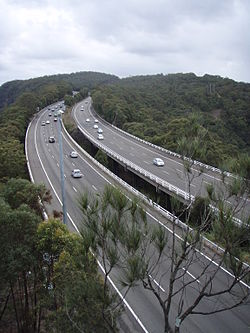
Close to Sydney, there are dual carriageways and motorways linking Sydney with the cities to the north, south and southwest – only the west is not connected via a motorway. The Hume Highway heading towards Albury and Melbourne and the Pacific Motorway/Highway towards Brisbane are high-speed dual carriageway for their entire length. Most roads to major centres are reasonable quality, with a single lane in each direction. It isn't uncommon when accessing smaller towns, or national parks to end up on gravel and dirt roads. See Driving in Australia for more information.
The state speed limit is 100 km/h outside of built-up areas unless otherwise signposted.
Roads are generally signposted to the next major town or city along the route. It pays to have at least a high level map of the state showing major towns along the route. If you are using a GPS, it pays to follow the signs through towns rather than following a short-cut suggested by the GPS. The GPS suggested shortcut along a minor or unpaved road won't save you any time.
Some popular NSW roadtrips:
Some road trips are about getting to where you are going, others are about the towns along the way, and others are just about the drive.
- The drive north from Sydney along the coast is all about the towns along the way. The road itself stays just far away from the coast to spoil the view, but each diversion to the coast is worthwhile.
- The drive down the south coast from Sydney to Batemans Bay and Eden is the classic coastal drive. The road stays by the coastline for much of its length, with numerous towns and villages to stop in. Divert at Batemans Bay for the pretty drive to Braidwood and Canberra.
- Drive around the Snowy Mountains in summer. As far as Cooma is just getting there. The real scenery starts there.
- Take a trip along Waterfall Way is windy roads and waterfalls up across the range, passing through the town of Bellingen.
- Take the 44-km descent on the Oxley Highway down. Descending rapidly from 1300 m to sea level in elevation in quite a short distance.
- Silver City Highway and Cobb Highway are for the outbackers who'd want bits of paved and unpaved roads.
By train
[edit]Trains in NSW are run by two agencies, Sydney Trains (within the Sydney metro area), and NSW Trainlink. NSW Trainlink runs NSW Trainlink Regional (booked/reserved), and NSW Trainlink Intercity (unbookable/unreservable) services.
Long distance
[edit]

NSW Trainlink Regional runs a network of trains to major destinations, and a network of connecting buses to offer a service to most New South Wales towns. It isn't exactly quick, or frequent, however some sort of service is generally offered to most towns once a day.
- Sydney to Coffs Harbour and Grafton via the Central Coast, Hunter Valley and North Coast, with some services continuing to Brisbane
- Sydney to Tamworth and Armidale via the Central Coast, Hunter Valley and New England.
- Sydney to Dubbo via the Blue Mountains and Central West.
- Sydney to Canberra via the Southern Highlands.
- Sydney to Albury on the Victorian Border, via the Southern Highlands and the Riverina, and continuing to Melbourne
- Sydney to Broken Hill (weekly, Monday to Broken Hill, and Tuesday return).
NSW Trainlink Regional trains are air-conditioned and equipped with comfortable seats. The overnight interstate trains to Melbourne and Brisbane have limited sleeping room available at a surcharge over a first class ticket.
Food, including hot meals, are available from a buffet car on board.
It is usual to book NSW Trainlink Regional tickets in advance. Tickets can be bought online, from agents, stations, or by phone. Some stations have very limited hours or no facilities for selling NSW Trainlink Regional tickets. Discounts are often available for advance purchase. You can buy tickets up until the time of departure, and services rarely run completely full outside of peak periods. It is essential to book NSW Trainlink Regional tickets in advance in some country towns as the stations do not open until the train is due. Some country towns are some distance from a rail station and a shuttle bus does the final stretch. The details are available when you book your ticket. Examples of this are at Port Macquarie and Walcha.
NSW Trainlink Intercity trains are integrated with the Sydney Trains network, and run a surprisingly long distance from the Sydney city centre, even overlapping with the routes of some NSW Trainlink Regional services. Where they do overlap, it is usual for the NSW Trainlink Intercity service to be cheaper, more flexible (in that no bookings are required and they are integrated with Sydney Trains ticketing), and to allow luggage and bikes in the carriage. They are, however, a little slower. See destination articles for details and alternatives. You will not get an assigned seat, but that is never a problem except for peak hour for the first 30 minutes away from the city during peak commuter period. Locals don't often use NSW Trainlink Intercity for holiday travel, so you won't see any evidence of crowds on holidays and weekends - the busy times are during peak hour commutes.
- Sydney to Newcastle via the Central Coast
- Newcastle to Scone and Dungog via Maitland and the Hunter Valley. Taking this service from Sydney is very indirect service, and taking Sydney Trains over NSW Trainlink Regional will add considerable travel time.
- Sydney to Lithgow via the Blue Mountains (with bus connection to Bathurst).
- Sydney to Goulburn via the Southern Highlands
- Sydney to Nowra via the Wollongong and South Coast.
See the Sydney article for more information on Sydney Trains and Sydney trains and NSW Trainlink Intercity ticketing.
By bus
[edit]The bus routes in New South Wales are more extensive than the train routes but share the same fundamental design: they take travellers to and from Sydney, or to the region's major hub. Many towns have a bus service especially to meet the trains to and from Sydney in a nearby town.
There are some exceptions to the rule, and some long distance cross country bus services do run, often to provide connections to other state capitals, or between state major centres. These services can be run only a few times a week, and you will have to be lucky to make connections.
The tripfinder service will find journeys about around New South Wales up through Newcastle the Hunter Valley, Illawarra and Southern Highlands and through the state's major centres. Travel further afield, particularly between complex destinations is left as an exercise for the traveller. See the local guides.
- NSW Trainlink Regional - operates bus services throughout the state.
- Greyhound - also services from Sydney to other state capitals, servicing the towns along the way.
- Murrays specialises in the Sydney to Canberra route, but also offers services to the Snowy Mountains (during winter) and connecting Wollongong to the Southern Highlands. Murrays also connects Canberra to Narooma (with stops at Queanbeyan, Bungendore, Braidwood, Batemans Bay, Batehaven, Moruya, Bodalla, and other towns) and Wollongong (with stops at Collector, Goulburn, Marulan, Moss Vale, Robertson, Albion Park, Dapto, Unanderra and Figtree).
- Premier operates along national route 1, servicing the South Coast, Mid-North Coast, and Northern Rivers
- Sydney Transport Group[dead link] covers all Sydney suburbs as well as surrounding.
- Australia Wide Coaches operates coach services from Sydney to Orange, with stops at Katoomba, Lithgow and Bathurst.
By bike
[edit]- Main article: Cycling in New South Wales
Boxed bicycles can be taken on NSW Trainlink Regional trains as baggage for a small extra charge. NSW Trainlink Intercity services allow bikes to be carried free of charge outside peak weekday periods. Many New South Wales towns then have wide roads that enable them to be easily explored by bike.
See
[edit]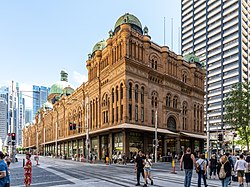
Landmarks
[edit]
By far, the state's, if not country's most famous and important landmark is, Sydney Harbour, also one of the state's favourite postcard scenes. It's best seen from the side of a ferry or from one of the islands in the centre, or one of the many lookouts in Sydney Harbour National Park.
While all are in Sydney, there are four world heritage-listed Australian convict sites in New South Wales: the Great North Road, Cockatoo Island, Hyde Park Barracks and the Old Government House in Parramatta.
So what is NSW's natural landmark you ask? That would be the Three Sisters in Katoomba, just within Blue Mountains National Park, receiving more than 8 million visitors annually. It's within the Sydney's extensive intercity train network and just an hour drive from Sydney CBD. Statistics and transport aside, the Three Sisters feature an iconic yet unusual rock formation. It's also Australia's most visited sacred Indigenous site; legend says they were turned into stone for protection.
Natural scenery
[edit]
Sydney is renowned for its large green spaces and national parks scattered throughout the city, but NSW’s true photogenic locations lie well outside Sydney, most located within its 225 or so national parks. Most important parks have access via sealed roads, but not all; most notably Mungo National Park, has no access via sealed roads, but instead can only be accessed via at least 80 kilometres of driving on unsealed tracks. But remember that Mungo is an outlier; there are many other impressive places that are accessible via car.
If you’re set out all of NSW’s nature, no trip is complete without visiting the Three Sisters; see § Landmarks. But you’ve visited the Three Sisters umpteen times already, the Blue Mountains alone has many impressive lookouts, along with the oldest cave system, Jenolan Caves. The world’s oldest tree, the Wollemi Pine was also discovered in the nearby Wollemi National Park, but the exact location is kept secretive.
Just to the north, starting in the Hunter are the many Gondwana Rainforests of Australia, stretching from Barrington Tops National Park all the way to Main Range National Park in the Darling Downs region of Queensland. Not all of them are popular tourist spots, but the ones that are in NSW include Dorrigo National Park, New England National Park, Nightcap National Park, and Oxley Wild Rivers National Park. These rainforests form a part of the Great Dividing Range, meaning there’s plenty of mountain scenery!
Further down the Great Dividing Range is the Snowy Mountains. Whilst it’s mostly popular with domestic tourists, it does attract quite a lot of international visitors, for one reason – its snowy wilderness. Most of the wilderness is protected under the Kosciuszko National Park, where there are many ski resorts, hiking trails and pristine, untouched wildness areas.
Wildlife
[edit]In captivity
[edit]- Western Plains Zoo, an open-range zoo in Dubbo. See Australian and exotic animals roaming in large paddocks rather than pacing in small cages.
- Taronga Zoo, across the Harbour from Sydney.
- Featherdale Wildlife Park in the Outer West of Sydney. Smaller than Taronga, but flat and emphasising Australian fauna.
- Australian Reptile Park in Gosford about an hour north of Sydney, with much more than reptiles. (Hint: Go early, move slowly, stay quiet and you can pet the 'roos.)
- Wild Life Sydney in Darling Harbour
- Mogo Zoo in Mogo
In the wild
[edit]Many coastal towns offer whale watching cruises during the season, including Sydney. Alternatively, there are many coastal vantage points where you can catch a glimpse if you are lucky.
- Go on a dolphin cruise in Jervis Bay
Do
[edit]
- Surf your way up the coast from Sydney to the north coast of New South Wales.
- Go on one of the bushwalks from Katoomba into the Jamison Valley.
- Hire a houseboat in any one of many bays, lakes and rivers.
- Ski in the Snowy Mountains in winter.
- Climb the Sydney Harbour Bridge and see the sun set over Sydney.
- Go to the Royal Easter Show in Sydney.
- Byron Bay's annual Blues and Roots festival is the state's largest roots music festival.
- Tamworth is Australia's country music capital and holds a country music festival in January each year.
- Camp in one of the many New South Wales national parks. (See www.nationalparks.nsw.gov.au)
- Go wine tasting in the Hunter Valley
- Climb Mount Kosciuszko in the Snowy Mountains.
- Fish at the heritage listed Willandra Lakes, and participate in the fishing competitions
Eat
[edit]The city of Sydney, unsurprisingly, represents the main food lovers' haven in New South Wales. It's the best place in the state to seek out both gourmet food and international cuisine. Particular highlights are Sydney's growing wave of Thai and fusion restaurants, and those top end restaurants whose chefs were often trained in some of the best international kitchens. Sydney's cosmopolitan population guarantees that just about every major cuisine on the planet is authentically and easily available - and generally at a great price.
Most coastal regions, including the Mid-North Coast, Northern Rivers, Central Coast, Sydney and the South Coast are a good place for seafood lovers to eat. Inland the catch may be a little less fresh.
Parts of the Central West specialise in meals made from local produce. Several of these restaurants feature regularly in the Sydney restaurant reviews, and they are beginning to have prices to match.
Vegans and vegetarians should be able to find a meal or two to suit them in almost every restaurant in the eastern part of the state, but are best catered for in Sydney and surrounds (including the Hunter) and after that, on the somewhat "alternative" Northern Rivers. However, that's not the case once you hit non-touristed areas inland.
Drink
[edit]Pubs, clubs and bars
[edit]- Sydney has much busier nightlife than the rest of the state and is the best place to find everything from international touring acts to backpacker bars and big beats. Other cities like Wollongong and Newcastle also have a diverse scene, with lots of choice of venues.
- Towns that cater to travellers and backpackers, like Byron Bay, Tweed Heads, and Batemans Bay, also have a selection of venues to choose from.
- Just about every country town in New South Wales will have at least one pub to choose from, from historical to the modern and upmarket. There is usually at least one club, being a bowling club, services club, etc. Visitors are welcome at pubs and clubs, and clubs usually have a sign out the front saying so. Meals and drinks are usually cheaper in the club, and depending on the town it can be slightly less rough and ready. Even country pubs will often have a band one or two nights a week, a pool table, juke box etc.
Wine
[edit]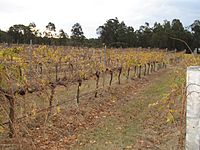
Wines are grown in many parts of New South Wales.
- The Hunter Valley is the state's major wine-growing region, and has a wine tourism industry to match. There are many winery tours from genteel wine-and-cheese tasting trips to minibuses full of partying backpackers and girls out on hens nights. Although a couple of hours drive north of Sydney, and is just a little too far for a comfortable day trip, it is less than an hour west of Newcastle via the Hunter Expressway (M15).
- Mudgee is another area of wine production, over the Blue Mountains.
Although tasting at the cellar door has a certain appeal, the wines themselves will certainly be cheaper at the bottle shop down the road.
Beer
[edit]Tooheys New (Lion) and Victoria Bitter (Carlton United) are the two big brands that will be on tap in most pubs around the state. Tooheys being the traditional New South Wales brand. Beer is served in schooners (smaller than a pint), or middies (about half a pint), so it is entirely reasonable to walk into most pubs and ask for 'schooner of new', and one will appear on bar. Beer glass sizes have different names and sizes in other states. On a hot day in a hot pub in the country, you will find more people drinking middles, as they stay colder.
New South Wales has followed the international trend towards craft beer, and there are more brands and types than you can poke a stick at.
James Squire, Cricketers Arms, Four Pines, Little Creatures, Yenda are some of the "crafty" brands put out by the multi-nationals available at many local pubs. There are hundreds of other independent microbreweries in New South Wales. The beers aren't hard to find if you look, but you'll have to seek them out rather than relying on the local pub to serve them.
It seems like every country town these days has its own craft brewing scene - and many wineries also having a shot at pouring the amber fluid as well. Outside of the big smoke, try Mudgee Brewing in Mudgee, or Badlands Brewery in Orange.
Sleep
[edit]Hotels
[edit]There are many hotels in New South Wales. Consult the sleep entries for the particular city you wish to visit.
Motels
[edit]Outside of weekends and school holidays it is usually possible to just drive and find accommodation along the road. Most towns of any size will have a motel or two on the road into town. Sometimes in low season they will display discounted standby rates at the gate as you drive past. If not, sometimes if they are not busy, a little discount can be negotiated at the counter. Generally expect motels to be cheaper the smaller the town, and the further away from the coast, the mountains, and Sydney that you are. Expect to pay a steep premium on weekends for those motels that are a "weekend away", for Sydneysiders.
Some of the chains covering many centres across New South Wales are:
- Country Comfort. Hotels and motels
- Golden Chain Motels. Has 100 locations in NSW.
- Best Western Motels.
- Choice Hotels.
Pubs
[edit]Just about every town has a pub offering accommodation. The standard varies from newly renovated to run-down, with many quaint places in-between. In winter it can even be an idea to take a small heater, as the heating in some can often be a little inadequate.
Serviced apartments
[edit]Serviced apartments are alternatives to traditional hotel accommodation with more space and cooking facilities.
- Quest Apartments. A chain with apartments available in most urban and regional cities in New South Wales.
Stay safe
[edit]Dangerous fauna
[edit]There are no box jellyfish or crocodiles in New South Wales. However there are "blue bottle" jellyfish common in several areas, that can give you a sting and a rash. The little blue balloon like creatures washed up the beach are a warning.
There are various types of shark swimming along the beaches, and attacks are frequent enough to warrant care. Try and swim only on patrolled beaches.
The Blue Ringed Octopus is one of the world's few venomous octopuses, and can be easily identified by being small and having distinctive blue rings.
Funnel Web Spiders are potentially deadly and found in Sydney and the surrounding areas. If you suspect that a funnel web has bitten you then call emergency services right away for anti-venom.
Snakes, including the dangerous Brown Snake are found in rural areas, and even in the bushland suburbs of Sydney.
Natural disasters
[edit]There are very few tropical cyclones or hurricanes, and tornadoes are very rare in New South Wales.
Some areas are prone to flooding, and some country towns, like Bellingen, have minor roads with low level bridges that can be cut even with moderate rainfall levels. Other roads that are unpaved or dirt, or have floodways can also be impacted. It is unusual for the major transport routes to be closed.
Be aware of the bushfire risk in summer if hiking in national parks.
Exposure
[edit]Even when close to Australia's biggest city, it is surprisingly easy to get lost in the vast countryside, particularly in the Blue Mountains. Many areas are unshaded with no easy access to water, so getting lost can be deadly.
Respect
[edit]Smoking is banned indoors in all public buildings, bars, restaurants and transport, and in private cars with children. It is banned outside in all areas where food is served. Many pubs and clubs have established outdoor areas with covers and heaters to facilitate smoking where eating is prohibited. If you are sitting inside you're guaranteed to be smoke-free. Outside, and you should check the signs as most of the outdoor areas are also smoke-free zones.
Like smoking, vaping is generally frowned upon and is banned in most places where smoking is banned. "No smoking" signs include vaping.


